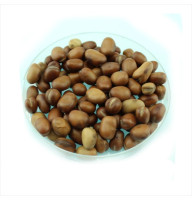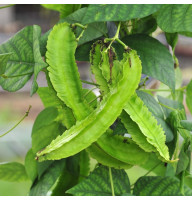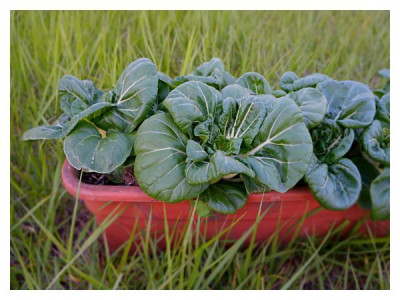In its natural environment, the four-winged plant grows in the Mediterranean, South Australia and Argentina, and is cultivated as a cultivated plant in the UK. Moreover, thanks to its beautiful purple inflorescences, it often settles not in garden beds, but in flower beds.

The botanical name of this unusual and beautiful plant sounds intriguing: purple four-winged plant, or purple tetragonolobus (Tetragonolobus purpureus). In the post-Soviet expanses, the crop appeared relatively recently, but in Europe, particularly in England, it has been cultivated for centuries. It was there that these peas were nicknamed asparagus peas - for the similarity of the taste of young fruits with asparagus beans.
Botanical features of asparagus peas

This bushy annual plant is a representative of a separate genus of the Legume family, which received its name for the original shape of the fruit: along the bean, on its four sides, there are symmetrical outgrowths, similar to thin wings. Hence another popular name – winged beans.
The flexible spreading stems of the four-winged plant are covered with fleshy, pair-pinnate leaves of a rich green hue with slight pubescence. An adult bush can reach a height of 3 m. During flowering, bright inflorescences of ruby-red, pinkish, yellowish or white color (depending on the variety), sometimes with a yellow center, bloom on the shoots. With their “scattering” of petals, they resemble light butterflies. After flowering ends, unusual tetrahedral beans develop in the leaf axils, which grow at an angle to the stem or vertically upward, unlike the fruits of other legumes.

Asparagus peas have not yet gained much popularity among gardeners, but they can already be found on sale. This plant reaches a height of about 2 m and needs to be supported.
How to sow snap peas
Four wing seeds are quite hard, so to speed up the emergence of seedlings, it is recommended to soak the peas for a day or two, and then germinate them in a damp cloth or cloth. This pre-sowing treatment is especially necessary for seeds older than two years.
Since asparagus peas are a fairly frost-resistant plant, the seeds can be sown in open ground as early as late April or early May. And to protect against return frosts, it is advisable to cover the sowing site with light spunbond or film until shoots appear.

The culture is not too demanding on the soil, but prefers that the soil is not too cold and damp. Snap peas will grow best in sunny locations with well-drained, moderately moist soil.
You can sow asparagus peas, like regular vegetable ones, in single or double rows, in a zigzag stitch or in a checkerboard pattern. For any sowing method, it is recommended to maintain a distance of 40-50 cm between rows and 8-10 cm between bushes in a row.
If the area is small, you can sow peas in nests, placing them at intervals of 25x25 cm.

After sowing, it is important to ensure that the soil remains slightly moist at all times. Under favorable weather conditions, seedlings usually appear within 2-3 weeks.
To speed up flowering and fruiting, four-winged plant can be grown through seedlings. At the end of March or beginning of April, the seeds are sown in peat pots. Care for seedlings in the usual way (watering, ventilation, fertilizing with an organomineral complex for seedlings in the phase of 2-3 true leaves). Planted in the ground after the end of return frosts.
Caring for asparagus peas in open ground

Further care for the four-winged plant does not require much effort and consists of timely watering, removing weeds, loosening and fertilizing with complex fertilizers every two weeks.
Like most legumes, Tetragonolobus has a long period of flowering and fruit formation (from June until almost the end of summer), during which the plant needs regular watering. In dry conditions, beans quickly become coarse, and excess moisture reduces yield. On average, the crop needs to be watered once a week in normal weather or twice during drought.

As they grow, it is recommended to install supports (best from knotty sticks) and tie the growing stems to them so that they do not lie on the ground. This will make it easier to prevent fungal diseases and more convenient to harvest.
The same pathogens are dangerous for winged beans as for related crops. They may suffer from rust, anthracnose, powdery mildew - usually infection occurs due to poor agricultural practices and unfavorable weather. If infected at the beginning of the growing season, plantings can be sprayed with a solution of 1% Bordeaux mixture. If symptoms of the disease appear already during flowering or fruiting, non-toxic biofungicides, for example Fitosporin-M, should be used for treatment.
Among garden pests on asparagus peas, the most common are aphids, pea weevils, and weevils. To combat them, plants are sprayed with industrial insecticides (Aktara, Inta-Vir) at the beginning of growth or with folk remedies (soap solution, decoctions of tobacco and wormwood, ash infusion) - if fruiting has already begun.

The harvest is harvested as the beans ripen: usually the pods are picked when their length reaches 3-4 cm. Overgrown pods quickly become coarse, turn black and become unsuitable for consumption. Such fruits are left for seeds: picked, dried, threshed and stored in fabric bags or paper bags. Four winged seeds remain viable for up to 4 years.
For a longer harvest, asparagus peas can be planted in several stages, taking into account the fact that full maturity occurs 2-2.5 months after planting.
Interestingly, all parts of this plant can be eaten: stems, leaves, young pods, beans and even roots. In terms of their nutritional properties, the fruits of asparagus peas are similar to soybeans: they have a fairly high protein content, as well as vitamins and unsaturated fatty acids.

The fleshy pods are eaten when semi-ripe. To remove slight bitterness, they are doused with boiling water and boiled in a small amount of salted water for about 5 minutes, after which the water is drained and the pods are seasoned with melted butter. Alternatively, you can steam the snap peas. In this form, seasoned with chopped dill, basil or parsley, it can be eaten as an independent dish, or added to salads, soups and side dishes.
Even if you are a great conservative and have never heard of the existence of winged beans, try growing them at least as an ornamental crop. And then you look - you decide to try a culinary experiment.









Write a comment